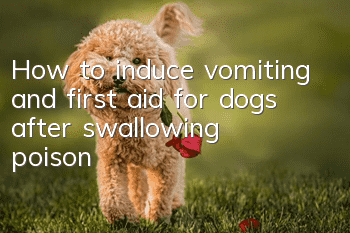How to induce vomiting and first aid for dogs after swallowing poison?

Imagine you come home and find that your dog isn’t doing well. After looking around you realize that your dog may have swallowed something very dangerous. Although making your dog vomit is not a good thing, it is a common first aid method for poisoning. Below we will briefly introduce some simple methods to induce vomiting in dogs.
Method 1: Administer hydrogen peroxide
1. Determine whether the dog needs to be induced to vomit. Before inducing vomiting, confirm whether this is necessary. If your dog swallows any of the following, you should induce vomiting at home:
* The dog swallowed antifreeze within the past 2 hours;
* Chocolate;
*Grapes or raisins;
* Paracetamol or aspirin;
* Plants, such as azaleas or daffodils.
2. Find a suitable place. If the dog is lying on the bed or on the carpet, you'd better move it to a place before inducing vomiting, such as outside or another place where the vomit can be easily cleaned. A room with tiles is good.
* If the dog is very weak, it may not be able to walk on its own. You need to hold it or at least help it get to the right place.
3. Feed a small amount of food before inducing vomiting. It may sound strange to give your dog something to eat before inducing vomiting, but it can actually help induce a vomiting response in your dog. A bit of canned food or a slice of white bread are good options.
* Canned food is easier to eat and tastes better than dry food;
* The dog may not take the initiative to eat. At this time, you should put the food directly into the dog’s mouth and try to let it eat;
* It doesn’t take too much time to get the dog to eat.
4. Contact your veterinarian. This is important! Try not to induce vomiting in your dog before contacting your veterinarian. When you call, you should provide as much information as possible so they can tell you what to do next (and what not to do). Important information includes:
* What do you suspect your dog has eaten (poisonous plants, house cleaning supplies, chocolate);
* How long do you think the dog has been eating these things;
* Symptoms shown by dogs;
* The size of the dog.
5. Determine how much 3% hydrogen peroxide your dog needs. If the veterinarian says it can induce vomiting, then give the dog 3% hydrogen peroxide, which is a relatively easy-to-use emetic for dogs. The dosage is one teaspoon per 4.5kg of body weight.
* You can use a measuring spoon to correctly calculate the amount of hydrogen peroxide.
6. Administer hydrogen peroxide. Put the hydrogen peroxide into an ear or eye drop bottle. As far as possible on the dog tongueThe farther back the roots are, the better, squeeze out the hydrogen peroxide and let the dog swallow it.
* Do not mix hydrogen peroxide with your dog’s food or drinking water.
7. Let the dog move. Moving around can stimulate the vomiting response by mixing the stomach contents with the hydrogen peroxide. You should walk your dog for a while after taking it. If your dog is immobile, gently rock or move his belly.
8. Wait for your dog to vomit. Dogs usually vomit within a few minutes of ingesting hydrogen peroxide. If there is no sign of vomiting after 10 minutes, give another dose of hydrogen peroxide.
* Some information says that hydrogen peroxide should not be used more than twice. Some say it can be done up to three times. Please consult your veterinarian before giving the third dose.
Method 2: Take your dog to the animal hospital for treatment in time
1. Seek medical treatment promptly. Even if you have successfully induced vomiting, the dog still needs to be treated by a veterinarian. Inducing vomiting is only a first aid measure and cannot expel all toxic substances from the dog's stomach. If the dog is not vomiting, veterinary treatment is even more critical - meaning the dog needs a stronger stimulus than hydrogen peroxide to induce vomiting.
* If your dog vomits, you can take a photo of the vomit and bring it to the veterinarian.
2. Tell the veterinarian what happened. Even though you may have contacted your veterinarian ahead of time, it's worth repeating the situation during the vet's examination, including how much hydrogen peroxide was used and how many times it was drunk.
* If your dog vomits, describe what the vomit looks like, or take photos directly to your veterinarian.
3. Let the veterinarian carry out treatment. Your veterinarian can provide medications to induce vomiting, as well as medications to prevent the poison from being absorbed. Activated charcoal, for example, binds to toxic substances in the digestive system and prevents them from being absorbed.
* Apomorphine is an opioid that can be used to induce vomiting. It usually takes effect within 5 to 10 minutes;
* A drug called xylazine can also be used to induce vomiting in dogs;
* The veterinarian will choose the best treatment method based on what the dog has swallowed.
Method 3: Other methods of inducing vomiting
1. Certain things cannot induce vomiting after being swallowed. Some substances can cause a lot of damage if vomited out after being eaten. If you know your dog has swallowed food that is one of the following, please do not induce vomiting:
* Bleach
* Water pipe cleaning agent
*Substances containing petroleum, such as gasoline
2. Observe the signs of severe poisoning. If the dog is seriously ill or has lost its response to the outside world, inducing vomiting is very dangerous. likeIf your dog shows signs of severe poisoning, do not induce vomiting and take your dog to a doctor immediately. The following are symptoms of severe poisoning:
* Difficulty breathing
* Depressed spirit
* Twitch
*Slow heart rate
* Lost consciousness
3. Do not use ipecac preparations or salt to induce vomiting. Ipecac syrup was once recommended for inducing vomiting in dogs, but this medicine will stay in the stomach for a long time and cause great irritation to the stomach if the dog cannot vomit. It is no longer recommended to use salt as it can be toxic in excess.
4. Induce vomiting quickly: If possible, let the dog vomit the poisonous substance within about 2 hours after eating it. After 2 hours, these toxic substances have moved into the small intestine, so inducing vomiting is useless.
Note: Sharp objects can cause damage to the stomach or esophagus. If you know your dog has swallowed a sharp object, do not induce vomiting.
- Why do pets smell bad? Is it helpful to use Aineng pet deodorant?
- Dog's diarrhea is like mud and smells bad but he is in good spirits
- Where do fleas on dogs come from?
- Border Collie toilet training, a must-read for novice dog trainers!
- What medicine should a golden retriever have diarrhea? Is it okay to give oxytetracycline to a golden retriever dog with diarrhea without eating?
- The smile of the Shiba Inu, which is very popular recently. How old does it take to teach a Shiba Inu to smile?
- Why do dogs need to be neutered? 8 benefits of neutering your dog!
- Do dogs need anti-inflammatory injections after giving birth to puppies?
- When is the best time for dogs to take deworming medicine?
- Is the Brazilian Mastiff easy to raise? What are its characteristics_Pictures



